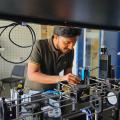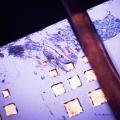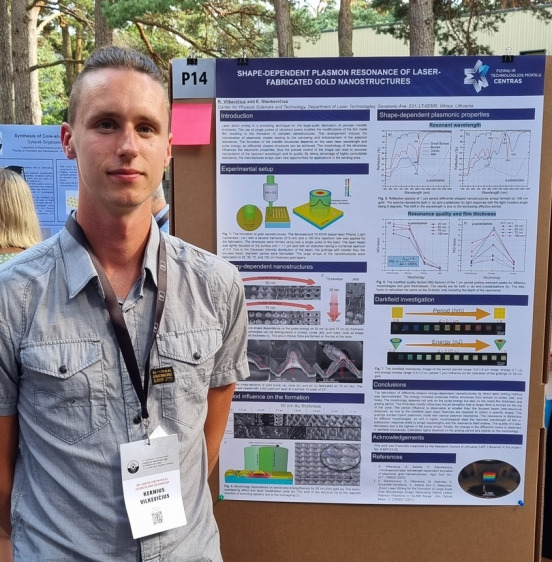- Home
- Nekoreguojami
- Search
Search
2023. 08. 30
-
FTMC poster presentations - the best at the Conference for the young scientists
The 25th International Conference-School "Advanced Materials and Technologies 2023" was held in Palanga from 21 to 25 August for PhD students and young scientists interested in Materials Science. At the Conference, four FTMC representatives received awards for the best poster presentations: Kernius Vilkevičius, Kasparas Stanaitis Aivaras Špokas and Jorūnas Dobilas.
Congratulations to our colleagues!
.jpg)
(Authors of the best poster presentations. From left: Aivaras Špokas (first), Kernius Vilkevičius (third), Kasparas Stanaitis (fourth) and Jorūnas Dobilas (fifth). Photo by the organisers)
Kernius Vilkevičius, a first year PhD student at FTMC (PhD supervisor Dr. Evaldas Stankevičius), presented a poster "Shape-dependent plasmon resonance of laser-fabricated gold nanostructures", which was awarded as the best poster presentation. The work was carried out at the Plasmonics and Nanophotonics Laboratory of the Department of Laser Technologies at FTMC.
The field of plasmonics has been of interest to researchers worldwide for some time because of the phenomenon of plasmon resonance, which can be applied to sensors, as it is sensitive to the refractive index of the environment and to the size of nanoparticles. Sensitive plasmonic substrates are often produced by expensive or time-consuming lithographic methods, so new fast and accurate methods are in high technological demand.
This work presents the formation of nanoparticles with different morphologies forming plasmon-exciting lattices, produced by a direct laser patterning method being developed in the Department of Laser Technologies, and the influence of shape on the plasmon resonance. By precisely controlling the shape of the lattice derivatives, it is possible to adjust the resonance quality and the location in the spectrum, which opens up a wide range of applications in the field of sensing. The results are closely related to the objectives of the Research Council of Lithuania Research Groups' project No S-MIP-23-32.
a.jpg)
(Photo by the organisers)
Kasparas Stanaitis, a technician at the Department of Optoelectronics at FTMC, received an award for his poster presentation "Cost efficient fabrication and analysis of paraffin lenses for THz radiation".
The study looked at a simple way to produce lenses for terahertz radiation by moulding them from cheap and readily available paraffin. It was found that, due to its favourable optical properties in the THz band (good transmittance and relatively high refractive index), paraffin can be efficiently used to produce high quality optical components that are suitable even for terahertz imaging systems.
Kasparas' work, by the way, has won the special award for the best poster presentation in optics. Young scientist was awarded by the Optica Society for Optics and Photonics.
Aivaras Špokas also works as a technician in the Department of Optoelectronics. He was awarded the prize for his presentation "Optimisation of GaAsBi Rectangular QWs for Emission at 1-1.2 µm". The main task of this work was the optimisation of the technology for the growth of single crystal gallium arsenide bismide (GaAsBi) quantum wells by molecular beam epitaxy (MBE).
Quantum wells are nowadays used in the production of light-emitting diodes and lasers, so it is important to have a good understanding of the growth technology in order to grow efficient semiconductor quantum structures. Gallium arsenide bismide is an attractive material for near-infrared (NIR) applications due to its stability at room temperature and suppression of Auger recombination.
In particular, the emission band (1-1.2 micrometres) chosen by Aivaras and the team can be used in the production of selective ambient gas detectors or even in wearable devices (smart watches) as blood oxygen concentration sensors, since the NIR band is safe for humans and invisible.

(Photo from the organisers' Facebook account)
The fourth winner, Jorūnas Dobilas, an engineer from the Department of Functional Materials and Electronics, gave a poster presentation on "Analysis of electrical and magnetic properties of manganites using the Ising model". The main objective is to try to describe the electrical and magnetic properties of thin layers of mineral polycrystalline manganites using two simple methods: the Ising model and the impedance network model (from the former it is possible to obtain the magnetic properties and from the latter - the electrical ones).
A modification of the two-dimensional Ising lattice (introducing functional dependencies of the substitution interaction) was used to assess the influence of the intercrystalline medium on the above properties.
The developed model is easily extendable, i.e. it can be easily modified by inserting defects, changing the crystallite structure etc. The model can also be modified to predict the properties of thin manganite layers from their growth parameters.
This year, 23 lecturers delivered lectures at the International Conference and 102 poster presentations were given in the poster session. Of these, 8 posters were recognised as the best.
FTMC information

Related news:

2023. 07. 27
-
PhD student has developed a sensor that promises a breakthrough in the food industry
Vytautas Žutautas never thought he would ever do chemistry in his life. But suddenly he discovered his own way in this field.

2023. 06. 12
-
A new tool to control light: FTMC talent from India has developed a promising hybrid lens
One of the goals of researchers around the world is to see diffractive optics used in smartphones.

2023. 05. 29
-
Thinner than a hair, as powerful as a laser: a new invention by FTMC physicists
PhD student Vladislovas Čižas talks about what Lithuanians were the first in the world to prove.

-3f61eed94a14641c1b7b959f0775d214.jpg)